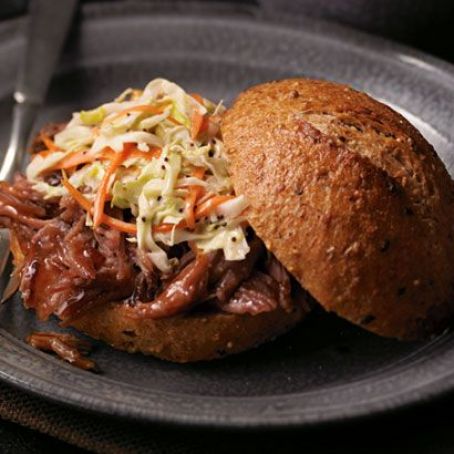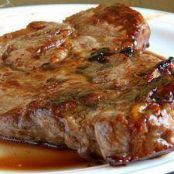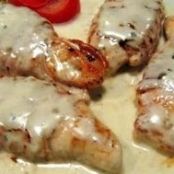Smoky Pulled Pork on a Gas Grill
By Venzie
Why this recipe works:
It’s often difficult to imbue pulled pork with rich, smoky flavor when cooking on a gas grill. We cut our pork butt into three pieces to increase the surface area that the smoke could cling to. After salting the pork overnight, we take it directly from the fridge to the grill: The meat’s cool temperature allows more smoke to condense onto its surface.
Instead of inundating the meat with smoke at the beginning, we get the most out of the wood chips by soaking half of them in water to delay when they begin to smoke. Our foil packets are the right size and shape to sit on the grill, and they have just the right size and number of openings to allow in enough oxygen so that the chips smolder, but not so much that they catch fire. Finally, we stir together a bright and spicy vinegar sauce that highlights the pungent smoke flavors of our pulled pork.
Pork butt roast is often labeled Boston butt in the supermarket. We developed this recipe with hickory chips, though other varieties of hardwood can be used. (We do not recommend mesquite chips.) Before beginning, check your propane tank to make sure that you have at least a half-tank of fuel. If you happen to run out of fuel, you can move the pork to a preheated 300-degree oven to finish cooking. Serve the pulled pork on white bread or hamburger buns with pickles and coleslaw.
Ingredients
- Pork
- Kosher salt and pepper
- 2 teaspoons paprika
- 2 teaspoons packed light brown sugar
- 1 (5-pound) boneless pork butt roast, trimmed
- 9 1/2 ounces wood chips (4 cups)
- 2 (9-inch) disposable aluminum pie plates
- 1 (13 by 9-inch) disposable aluminum roasting pan
- Vinegar Sauce
- 2 cups cider vinegar
- 2 tablespoons ketchup
- 2 teaspoons packed light brown sugar
- 1 teaspoon red pepper flakes
- 1 teaspoon kosher salt
Details
Servings 8
Adapted from tastefullysimple.com
Preparation
Step 1
1. FOR THE PORK: Combine 5 teaspoons salt, 2 1/2 teaspoons pepper, paprika, and sugar in small bowl. Cut pork against grain into 3 equal slabs. Rub salt mixture into pork, making sure meat is evenly coated. Wrap pork tightly in plastic wrap and refrigerate for at least 6 hours or up to 24 hours.
2. Just before grilling, soak 2 cups wood chips in water for 15 minutes, then drain. Using large piece of heavy-duty aluminum foil, wrap soaked chips in 8 by 4 1/2-inch foil packet. (Make sure chips do not poke holes in sides or bottom of packet.) Repeat with remaining 2 cups un-soaked chips. Cut 2 evenly spaced, 2-inch slits in top of each packet.
3. Remove cooking grate and place wood chip packets directly on primary burner. Place disposable pie plates, each filled with 3 cups water, directly on other burner(s). Set grate in place, turn all burners to high, cover, and heat grill until hot and wood chips are smoking, about 15 minutes. Turn primary burner to medium and turn off other burner(s). (Adjust primary burner as needed to maintain grill temperature of 300 degrees.)
4. Clean and oil cooking grate. Place pork on cooler side of grill, directly over water pans; cover; and smoke for 1 1/2 hours.
5. Transfer pork to disposable pan. Return disposable pan to cooler side of grill and continue to cook until meat registers 200 degrees, 2 1/2 to 3 hours.
6. Transfer pork to carving board and let rest for 20 minutes. Pour juices from disposable pan into fat separator and let stand for 5 minutes.
7. FOR THE VINEGAR SAUCE: While pork rests, whisk all ingredients together in bowl. Using 2 forks, shred pork into bite-size pieces. Stir 1/3 cup defatted juices and 1/2 cup sauce into pork. Serve, passing remaining sauce separately.
What Were We Smoking?
In our quest to get the richest smoke flavor possible into pulled pork made on a gas grill, we experimented with other sources of smoke beyond the traditional wood chips. Our conclusion? Getting things like cinnamon sticks to smolder on the grill is fun and quirky, but wood chips still provide the best smoke flavor.
PANTRY FINDS: When wood smolders, the cellulose, hemicellulose, and lignin compounds that it contains break down and flavor food. So we looked for pantry items with a similar makeup to see if they would work any better. Cinnamon sticks, dried garbanzo beans, and walnut shells all produced smoke, but it was weak—almost sweet—rather than bold, as you’d expect with wood-smoked barbecue.
PUCKS, BRICKS, AND PELLETS: Made by compressing wood chips and sawdust, smoker pucks and bricks were hard to arrange on the gas grill, and they usually caught fire. Wood pellets and sawdust-type products, sealed in a foil packet according to their instructions, required frequent refueling for pulled pork—they would be fine for a quickly smoked pork chop but were not worth the effort here.
The Importance of a Just-So Packet
In the past, we’ve found that sealing wood chips in a foil packet with a few slits cut into it is the best method for producing smoke on a gas grill. We confirmed that that’s still the case, but we also found that our directions for making a packet have been too vague. By ironing out the details, we ensure consistent, steady smoke from one packet to the next.
Eight by 4 1/2-inch packets hold 4.75 oz of chips, the maximum amount that will fit on the burner.
Two 2-inch-long slits let in just enough oxygen for a steady smolder. (Be careful that the slits don’t get blocked by the grate’s bars.)
Weigh the chips—don’t measure by volume—since chips vary greatly in size.
Since the pork can absorb only so much smoke at any moment, soak half of the chips to draw out the smoke over a longer period.
Maximizing Smoky Flavor on a Gas Grill
In addition to getting the details of the wood chip packet just right, we made several other small adjustments that together paid off with big smoky flavor.
INCREASE SURFACE AREA: Cutting a 5-pound boneless pork butt roast into three equal slabs provides more total surface area for the smoke to cling to.
ADD HUMIDITY: Placing two water-filled pans in the grill creates a humid environment that keeps the surface of the meat moist, which allows for better absorption of water-soluble smoke compounds.
PUT COLD PORK ON GRILL: Smoke will condense more easily on a cold surface, so we put the pieces of pork on the grill straight from the fridge rather than bringing it to room temperature as many recipes suggest.
CATCH THE SMOKY JUICES: When the smoke peters out, putting the pieces of pork in a pan saves smoky juices that can be added back before serving.
You'll also love
-
 Gluten-Free Blueberry Cobbler
4.5/5
(15 Votes)
Gluten-Free Blueberry Cobbler
4.5/5
(15 Votes)
-
 Apple & Poppy Seed Coleslaw
4.4/5
(20 Votes)
Apple & Poppy Seed Coleslaw
4.4/5
(20 Votes)
-
 Bacon Cheddar Biscuit Snackers
4.5/5
(15 Votes)
Bacon Cheddar Biscuit Snackers
4.5/5
(15 Votes)




Review this recipe